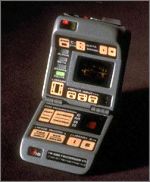Alongside tremendous technological advancements achieved with the passing of three millennia, the field of medicine has kept pace with equally startling improvements. Life expectancy is 40 percent longer for humans on earth, a leap from 75 years to 125. Diseases that used to pose a threat to the human race are exterminated and practicing medicine is no longer as intrusive as it used to be.
Perhaps owing to a longer lifespan and a broader vision of the universe due to the exploration led by Starfleet vessels, the Terran attitude toward life has developed into an emphasis on non-interference and equality in treatment of any form of sentience. The age-old prejudice against the unknown has largely been conquered by charity and respect for diversity championed by the Federation. The keeping of ancient traditions by taking the Hippocratic Oath at Starfleet Medical is in ways symbolic of the Federation's resolve to relieve suffering and offer assistance to worlds torn by violence.
Medical Tricorders
 The Federation is in itself a highly diversified organization, with differing native physiology on each member planet. To attend to the medical needs of its multi-cultural officers as well as those of unfamiliar life forms, Starfleet has developed medical devices that work well with humanoid species. Techniques in the diagnosis of various illnesses have also been refined. Armed with the medical tricorder, a precise scanning tool every cadet is trained to use, Starfleet officers can analyze alien life forms, identify human conditions. Besides mere identification of problems or conditions, these tricorders are capable of giving a calculated diagnosis of medical problems unknown to have existed before, all of which makes the medical tricorder invaluable to medical officers at the frontier of the universe. The instrument has a range of one meter, but most doctors tend to use them at about 10 centimeters from the patient to eliminate erroneous readings caused by atmospheric interference.
The Federation is in itself a highly diversified organization, with differing native physiology on each member planet. To attend to the medical needs of its multi-cultural officers as well as those of unfamiliar life forms, Starfleet has developed medical devices that work well with humanoid species. Techniques in the diagnosis of various illnesses have also been refined. Armed with the medical tricorder, a precise scanning tool every cadet is trained to use, Starfleet officers can analyze alien life forms, identify human conditions. Besides mere identification of problems or conditions, these tricorders are capable of giving a calculated diagnosis of medical problems unknown to have existed before, all of which makes the medical tricorder invaluable to medical officers at the frontier of the universe. The instrument has a range of one meter, but most doctors tend to use them at about 10 centimeters from the patient to eliminate erroneous readings caused by atmospheric interference.
24th Century Surgery
 Surgery in the 24th century has advanced to become as non-invasive as possible, utilizing Exoscalpels and Sonic Separators to make incisions without relying on a surgeons hands. Alpha Wave and Somnetic Inducers work as the standard anesthetic by lowering the patients' state of consciousness while not producing adverse side-effects. Some surgery can circumvent opening the body altogether. Anabolic protoplasers use force-fields and regenerative accelerators to quickly repair small wounds. For cases that require great precision, nanosurgeons, which are microscopic electronic "pores", can be injected into the patient's bloodstream and controlled from the physician through a computer.
Surgery in the 24th century has advanced to become as non-invasive as possible, utilizing Exoscalpels and Sonic Separators to make incisions without relying on a surgeons hands. Alpha Wave and Somnetic Inducers work as the standard anesthetic by lowering the patients' state of consciousness while not producing adverse side-effects. Some surgery can circumvent opening the body altogether. Anabolic protoplasers use force-fields and regenerative accelerators to quickly repair small wounds. For cases that require great precision, nanosurgeons, which are microscopic electronic "pores", can be injected into the patient's bloodstream and controlled from the physician through a computer.
Hyposprays
 But better than surgical techniques is not having to use them altogether. Most minor conditions (and in the 24th century, "minor" means anything short of life-threatening) can be repaired with instruments that accelerate the healing process. Almost all illnesses can be handled by medication injected through the epidermis with a hypospray. A hypospray shoots a high-pressured pinpointed stream of the medication, which penetrates the skin and most clothing without the prick of a needle.
But better than surgical techniques is not having to use them altogether. Most minor conditions (and in the 24th century, "minor" means anything short of life-threatening) can be repaired with instruments that accelerate the healing process. Almost all illnesses can be handled by medication injected through the epidermis with a hypospray. A hypospray shoots a high-pressured pinpointed stream of the medication, which penetrates the skin and most clothing without the prick of a needle.
Noting how life imitates art:
A hypospray of sorts has become reality. About two years ago, a medical invention that injects a high-pressured stream of fluid medication that penetrates the epidermal layer was developed and is being tested. Many people were reminded of the hypospray, including the CNN reporter. Who knows but we may not need 300 years to emulate more of the technology from Star Trek.
Quick Looks
The other sections of "Starfleet Medicine" offer more in-depth information on the various types of medical procedures, equipment, medicine, and diseases seen in Star Trek, while the Journal offers some researched evidence that supports or rejects certain biological concepts and medical practices used by Dr. Bashir and other Starfleet doctors.
Back to top